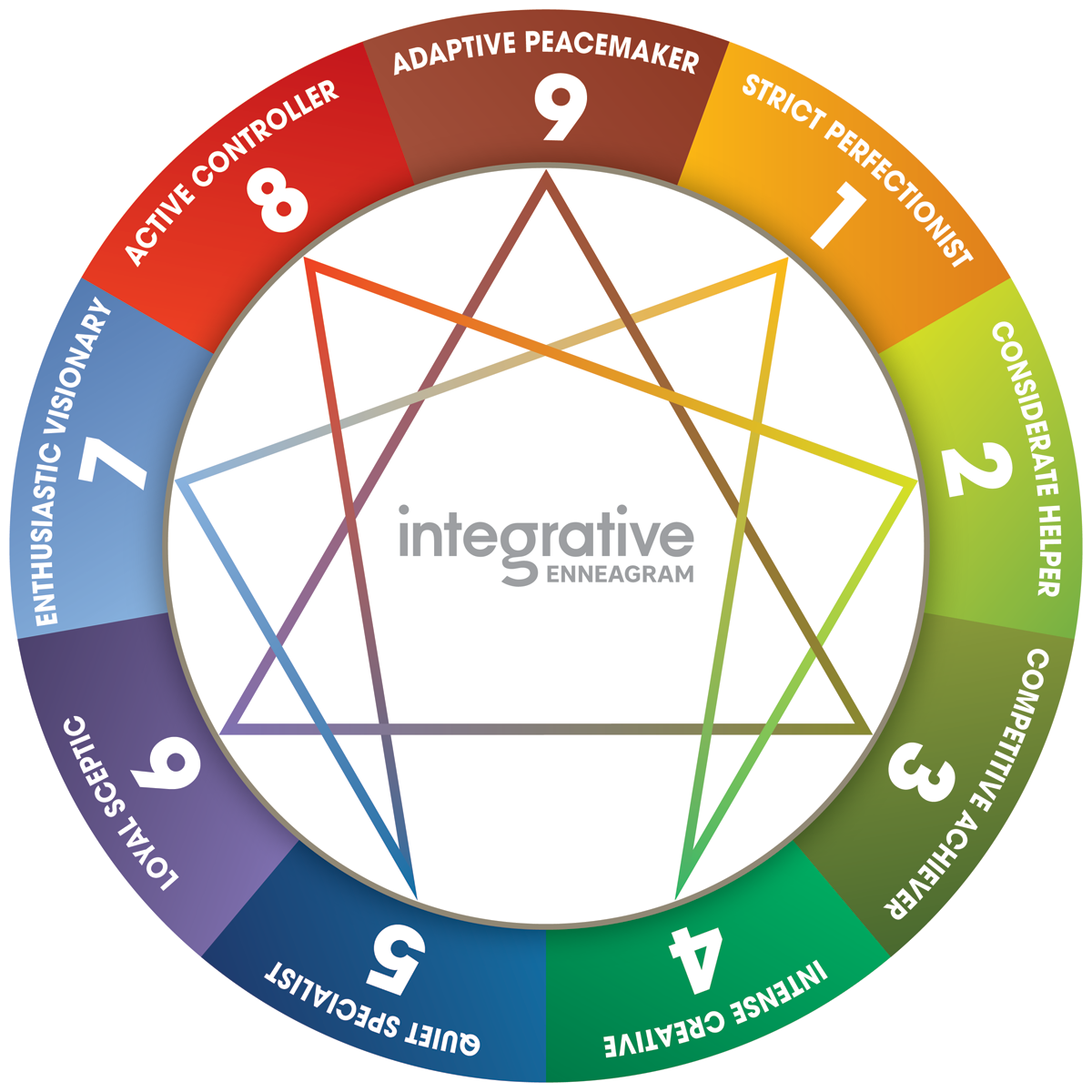
Enneagram Library
The Enneagram for Team Development:
An Overview of this Valuable Tool for Teams
Effective leaders recognize the value of using structured tools and methods to support team members and foster team cohesion. One tool that has gained popularity in the professional sphere in recent years is the Enneagram.
This article will explore the Enneagram—a powerful system for self-awareness—and how its use in a team environment facilitates individual growth and enhances team dynamics.
"Slow is smooth and smooth is fast. So, slow down to go fast."
What is the Enneagram?
The Enneagram is a personality typing system widely used in personal development. It sorts individuals into nine core personality types. Unlike other assessments such as the DiSC or the Myers-Briggs Type Indicator (MBTI), the Enneagram goes beyond behavioral patterns. Rather, it identifies a person’s underlying worldview. Knowledge of a person’s core type and corresponding worldview yields valuable insights about their strengths and weaknesses, how they approach interpersonal relationships, and what they need in order to grow.
What are the Nine Enneagram Types?
While the nine types are assigned slightly different names depending on the Enneagram resource consulted, we utilize and recommend the Integrative9 IEQ9 framework and IEQ9 test. Integrative9 identifies the nine core types as:
Type 1: The Strict Perfectionist
Type 2: The Considerate Helper
Type 3: The Competitive Achiever
Type 4: The Intense Creative
Type 5: The Quiet Specialists
Type 6: The Loyal Sceptic
Type 7: The Enthusiastic Visionary
Type 8: The Active Controller
Type 9: The Adaptive Peacemaker
Why does InnerWork Coaching recommend the Enneagram?
At InnerWork Coaching, we believe that in order to develop as a professional, one must make the time to grow as an individual. Long before we ask, "What should we do?" we must ask, "Who are we?"
By applying the Enneagram, we first deepen our understanding of ourselves. In doing so, we build greater self-awareness and also learn to use this framework to better understand others in our circle. This creates a powerful foundation of mutual understanding, which is highly applicable to professional areas such as conflict, care, communication, and more.
Here’s an example of how a previous client utilized the Enneagram framework to their professional benefit:
A previous client came to InnerWork after an internal restructuring created a new team that was struggling to achieve the cohesion necessary to work well together. After speaking with the leader, it became clear that the team members had not taken the time to develop a foundational understanding of one another. Once the leader applied the Enneagram framework and guided the team members in evaluating and understanding their own Enneagram types, a subsequent team-building session allowed the team members to deepen their understanding of one another. Since this session, the team has experienced deeper connection and understanding. In the present, they are working more effectively with one another as they operate from this foundation of understanding. The work this team has done with the Enneagram framework positions them for stronger and more successful team interactions in areas such as conflict resolution, communication, and collaboration.
Teams are made up of individuals. Strong teams depend on strong relational connections between these people, but these connections will only grow if they are nurtured. The Enneagram is a powerful tool that facilitates genuine connections within teams, allowing trust and authenticity to flourish while inviting the kinds of deep inner work that helps people—and, therefore, teams—grow. We know from experience that the Enneagram is uniquely effective at supporting both individuals and teams in these ways.
When leaders support their team members by setting aside time to get to know the people who sit around the table (themselves included), they create the foundation for ever more effective collaboration. No matter the question, deeper understanding at the individual level leads to better answers.
Six Ways the Enneagram Helps Teams Grow
Let's examine six specific areas where the Enneagram, as a curiosity-led framework, can enhance team engagement, promote personal growth, and yield improvements in the workplace:
Connection: Creating an atmosphere that fosters authentic connections leads to stronger relationships, increased trust, and a more effective team. The Enneagram supports the mutual understanding that creates an environment of authentic connection.
Care: Team members often wish to support each other, and the Enneagram helps illustrate how individuals prefer to receive care. By fostering a deep understanding of each team member, the Enneagram enables individuals to provide care in ways that resonate with others.
Communication: By applying their Enneagram knowledge, team members can better understand and appreciate each other's communication styles, both concerning what is communicated and how it is communicated.
Conflict: Productive conflict is necessary to develop high-trust teams that perform at their best. The Enneagram equips individual team members to recognize their own and their colleagues' underlying motivations, priorities, and fears. This allows team members to approach and effectively resolve conflicts from a foundation of understanding- of themselves and those around them.
Collaboration: Individuals can adapt their approaches to collaboration and leadership by understanding their own Enneagram type and those of their teammates. The insights gained through the Enneagram facilitate more successful interactions and increased engagement among team members.
Challenge: The Enneagram can be utilized to identify how team members can challenge one another to push toward goals, think deeply about decisions, and align on what success looks like. The care, connection, and communication that is illuminated by the Enneagram helps each individual understand what their team members need in order to challenge themselves in a productive way.
Tips for Leaders Using the Enneagram with Teams
While the Enneagram possesses significant effectiveness as outlined above, leaders must approach its application thoughtfully. Once leaders decide to integrate the Enneagram intentionally within their teams, the next step is to determine how and where to incorporate the tool.
As with any project undertaken in a team capacity, successful application of the Enneagram framework will require each team member to dedicate resources to this work. It will be important that the leader create a supportive environment in which each team member feels equipped with the necessary time and energy to devote to this new task. Just as a leader would not expect a team to reach a quarterly goal without the necessary support, leaders must ensure that team members feel resourced and enabled to spend valuable work time on this valuable work. Leaders who personally engage with the Enneagram and model its utility, as well as communicating the importance of shared understanding, create an opportunity in which teams can thrive.
Once adopted, the Enneagram maintains its effectiveness over time and continues to yield positive results, as long as team members and leaders continue to be willing to dedicate the necessary time, attention, and resources. When implemented successfully, team members are able to apply the framework in both established and new situations.
We have seen the most powerful results when leaders spend time and energy understanding themselves, the Enneagram, and those around them. Our Enneagram Team Leader Guide contains a step-by-step guide to support leaders seeking to use the Enneagram with their teams.
In Conclusion
The Enneagram helps us better understand our inner worldviews and how they manifest in our daily actions. It reveals our underlying motivations, which are often invisible to those around us. Utilizing the Enneagram creates a framework for conversations that will draw these underlying motivations to the surface. With insight into these motivations, people will begin speaking more openly and vulnerably. Because we are all human beings, this openness and vulnerability is necessary to develop the trust needed to work well together.
The Enneagram framework is a powerful tool when used by teams that devote the necessary time, attention, and resources. When effectively applied, it has the power to create stronger relationships and lead to greater success in the professional sphere.
Consistent use of the Enneagram empowers teams to discover new ways of understanding, communicating, and collaborating. The ultimate outcome is a high-performing team capable of achieving remarkable results.
-
The Enneagram is a powerful tool for self-reflection and personal development. We offer a range of Enneagram workshops in which our trained professionals support your team in applying the lessons of the Enneagram to support their growth as humans and their effectiveness in the workplace. Learn more.
-
We offer a range of additional team-oriented training programs and workshops that focus on supporting your team’s interpersonal engagement and functioning. Our workshops are designed to meet your team’s needs and focus on a variety of topics; all workshops utilize the training of our coaches to support and enhance the interpersonal health of your team. Learn more.
-
Individual coaching for Founders, C-Level Executives, and Managers. Our Individual Coaching services are focused on encouraging professional and vocation growth for individuals. Learn more.
Our Services
-
Our Team Coaching services are focused on supporting team members in order to improve interpersonal connection, communication, and effective interactions in the workplace. Learn more.
-
Cofounders often encounter unique challenges as they navigate their relationships while leading their company through intensive work. We have designed our Cofounder Coaching package for cofounders interested in intentionally strengthening their working relationships with their fellow founders. Learn more.
-
Qualitative 360° Leadership Reviews that involve identifying key stakeholders, conducting qualitative interviews, and synthesizing the data into a cohesive picture based on interpersonal development and the needs of the business. Learn more.


